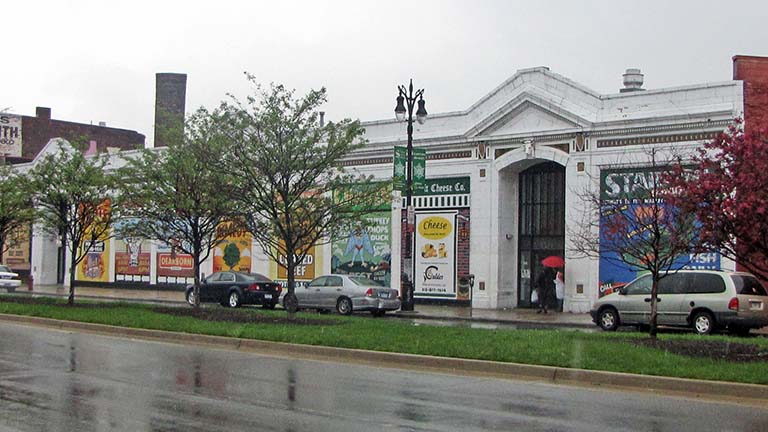

As early as 1841, farmers from the Detroit area began bringing their products to Cadillac Square to sell to city residents. After five decades or so, the city’s downtown became very busy and increasingly prosperous. The farmer’s market seemed out of place, so in 1891, it was moved to an area along Russell Street between Gratiot and Mack. This was known as Eastern Market. In the early 1890s, architect Richard Raseman designed the large sheds welcoming merchants every Saturday—and many week days—of the year. Additional sheds were put in place in 1922 and 1929. You might think that farmer’s markets specialized in the sale of home grown food and they do. But in the 1890s, Detroit merchants and residents need a great deal of fodder for their houses. This must have been one of the major products sold there. Around today’s Eastern Market, you see many late Nineteenth century buildings facing Napoleon, Winder, Adelaide and Market streets that housed stores selling food products.
In 1915, the building you see pictured here was designed by the Detroit firm of Smith, Hinchman and Grylls. It was to provide inside selling space for meats, dairy products, including eggs and what we now called canned goods. Customers, presumably, could buy directly from farmers at their stalls in the open air market and then walk into the Gratiot Central Market Building for their meats, milk, cheese and staples.
Originally, this was a two-story structure with one front facing Russell and another facing Gratiot. It included a saloon and a billiards hall but those are gone. One substantial fire in 1967 destroyed much of this market building. It was reconstructed as a one-story building. Another fire devastated the reconstructed building in 1995. The front wall along Gratiot was the only component of the original building that was retained. If you look closely, you will see three impressive terra cotta depictions of cattle heads at the roof line.
For much of the Twentieth Century, there were three thriving farmers markets in Detroit. Western Market was located at the corner of Michigan and Trumbull but was removed in 1895 to make way for the construction of Bennett Field which served as the home of the Detroit professional baseball team. This is the site where Navin Field or Tiger Stadium stood until it was razed in 2010. Western Market was shifted slightly southwest along Michigan to the area bounded, roughly, by Michigan, 18th, Humboldt and Butternut. The construction of the huge intersection of I-75 and I-96 occupies much of the area of the Western Market. It ceased operation in 1965. The third farmer’s market was located at the corner of Chene and Ferry and closed in 1990. Some of the sheds remain although they are falling apart.
Eastern Market is a thriving area of Detroit with retail food stores, many restaurants and bars. Quite a few nearby buildings converted to apartments or condominiums. This is the result of innovations in management. The financially strapped city of Detroit could not invest in improving or maintaining their Eastern Market. In the early 2000s, enterprising and entrepreneurial individuals, especially Detroit urban planner, Kate Beebe, saw the potential of the Eastern Market. They established a non-profit corporation, the Eastern Market Corporation and raised funds from the Kellogg Foundation, the Kresge Foundation and the McGregor Fund. After years of negotiations, Detroit’s Common Council, in 2006, agreed to turn the market over to this non-profit corporation. I believe the city retains ownership of the market and may appoint some members to serve on the board of the non-profit but the market is no longer supported or directly operated by the city. Presumably, the merchants doing business at or near the market are now its major supporters.
Date of Construction: 1915
Architects: Smith, Hinchman and Grylls
City of Detroit Designated Historic District: Not listed
State of Michigan Registry of Historic Sites: The Eastern Market Historic District, P25,084, was listed on November 29, 1978
National Register of Historic Places: The Eastern Market Historic District was listed on July 26, 1974
Picture: Ren Farley; May 15, 2014
Description prepared: May 18, 2014
Return to Commercial Sites
Return to Homepage